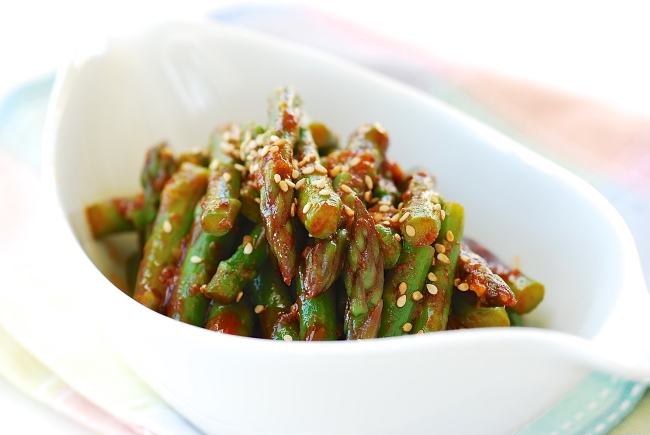This mini gimbap uses minimal ingredients, which takes no effort to roll up. I used three ingredients here ― pickled radish, carrot and spinach. This gimbap is called ggoma gimbap because of its small size. Ggoma means a little one or little kid in Korean. It’s also known as mayak gimbap. Mayak means narcotics, so the name comes from this gimbap’s reputation for being addictive. It’s a specialty of Gwangjang Market, a bustling, crowded market in the center city of Seoul, where the merchants came up with the idea to serve these little guys with a sweet and tangy hot mustard sauce.

A typical hot mustard sauce includes hot mustard called gyeoja, vinegar, soy sauce and sugar. Here, I tried it with dijon mustard and added finely ground sesame seeds for extra nutty flavor to pair with the sesame oil laden gimbap. It’s addictive!
Makes 16 pieces
Ingredients:
● 1-1/2 cups uncooked short grain rice (standard measuring cup not the cup that comes with a rice cooker)
● 2 teaspoons sesame oil
● salt to taste (start with 1/3 teaspoon)
● 1 small bunch spinach
● 1 teaspoon sesame oil
● salt to taste ― about 1/4 teaspoon
● 1 large carrot, julienned
● 4 yellow pickled radish (danmuji) strips, precut for gimbap
● 4 gim (dried seaweed) sheets
Sauce:
● 1 tablespoon sesame seeds, finely ground in a spice grinder or mortar bowl
● 1 tablespoon vinegar
● 1 teaspoon soy sauce
● 1 teaspoon dijon mustard (or Korean hot mustard, gyeoja)
● 1/8 teaspoon salt
● 2 teaspoons sugar
Cook the rice using a little less water than usual. (Fresh cooked rice is best for gimbap.)
Bring a large pot of water to a boil over high heat and prepare an ice bath. Blanch the spinach, place immediately in the ice bath, then squeeze the water out. Run a knife through the squeezed spinach a couple of times. Season with the sesame oil and salt.
Julienne the carrots. Heat a lightly oiled pan over medium high heat. Stir-fry the carrots until slightly softened. Lightly season with a pinch of salt.
Cut each strip of pickled radish crosswise in half, and then cut lengthwise in half.
When all the ingredients are ready, remove the rice from the rice cooker. While the rice is still hot, add the sesame oil and salt. Mix well by lightly folding with a rice paddle or spoon until evenly seasoned.
Cut four sheets of nori into quarters.
Put a quarter sheet of gim, shiny side down and shorter side toward you, on a cutting board. Spread 1 tablespoon to 1-1/2 tablespoons of rice evenly over the gim, leaving a little bit of space on the side away from you. Do this with your fingers. Keep a wet towel handy and wipe your fingers frequently to keep the rice from sticking to your fingers. Lay the prepared ingredients on top of the rice, closer toward you.
Lift the entire bottom edge with both hands and roll over the filling away from you, tucking in the filling with your fingers.
Rub or brush the roll with a little bit of sesame oil for extra flavor and a shiny look.

A typical hot mustard sauce includes hot mustard called gyeoja, vinegar, soy sauce and sugar. Here, I tried it with dijon mustard and added finely ground sesame seeds for extra nutty flavor to pair with the sesame oil laden gimbap. It’s addictive!
Makes 16 pieces
Ingredients:
● 1-1/2 cups uncooked short grain rice (standard measuring cup not the cup that comes with a rice cooker)
● 2 teaspoons sesame oil
● salt to taste (start with 1/3 teaspoon)
● 1 small bunch spinach
● 1 teaspoon sesame oil
● salt to taste ― about 1/4 teaspoon
● 1 large carrot, julienned
● 4 yellow pickled radish (danmuji) strips, precut for gimbap
● 4 gim (dried seaweed) sheets
Sauce:
● 1 tablespoon sesame seeds, finely ground in a spice grinder or mortar bowl
● 1 tablespoon vinegar
● 1 teaspoon soy sauce
● 1 teaspoon dijon mustard (or Korean hot mustard, gyeoja)
● 1/8 teaspoon salt
● 2 teaspoons sugar
Cook the rice using a little less water than usual. (Fresh cooked rice is best for gimbap.)
Bring a large pot of water to a boil over high heat and prepare an ice bath. Blanch the spinach, place immediately in the ice bath, then squeeze the water out. Run a knife through the squeezed spinach a couple of times. Season with the sesame oil and salt.
Julienne the carrots. Heat a lightly oiled pan over medium high heat. Stir-fry the carrots until slightly softened. Lightly season with a pinch of salt.
Cut each strip of pickled radish crosswise in half, and then cut lengthwise in half.
When all the ingredients are ready, remove the rice from the rice cooker. While the rice is still hot, add the sesame oil and salt. Mix well by lightly folding with a rice paddle or spoon until evenly seasoned.
Cut four sheets of nori into quarters.
Put a quarter sheet of gim, shiny side down and shorter side toward you, on a cutting board. Spread 1 tablespoon to 1-1/2 tablespoons of rice evenly over the gim, leaving a little bit of space on the side away from you. Do this with your fingers. Keep a wet towel handy and wipe your fingers frequently to keep the rice from sticking to your fingers. Lay the prepared ingredients on top of the rice, closer toward you.
Lift the entire bottom edge with both hands and roll over the filling away from you, tucking in the filling with your fingers.
Rub or brush the roll with a little bit of sesame oil for extra flavor and a shiny look.





